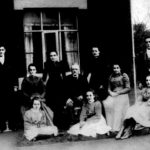The pumping station at Boar’s Head, also known as the Douglas Valley Pumping Station, was a facility of the Wigan Corporation Water Works and part of an extensive system supplying water to the growing town of Wigan (see also Worthington Lakes Reservoir). From circa 1892 Edward Harrison (b. 1855) was employed by the Water Works at Boar’s Head as an engine minder, operating and maintaining the steam engines that powered the water pumps. Perhaps because the pumps needed to operate 24 hours per day the Water Works provided Edward with a home at the site of the pumping station. Edward’s father Joseph Harrison (b. 1835) was also employed by the Wigan Corporation Water Works around this time (see Ellen Ball’s death certificate) however he did not live at the Pumping Station and we don’t know whether he worked there or elsewhere.
So it was that the Pumping Station at Boar’s Head was the workplace and home of Edward Harrison and his wife Martha Mason (b. 1855) when they both died tragically at age 39 in the autumn of 1894. Also living at this address at the time were their six children (eldest daughter Jane (b. 1878) had died in childhood) and Martha’s spinster sister, Elizabeth Mason. Edward’s obituary in the Wigan Observer stated that Edward was “in charge of the pumping station.”
When Edward and Martha died it fell upon Edward’s father and sisters to care for the six orphaned children. At this time the Wigan Corporation Water Works gave both Edward’s job, and the residence that came with it, to Edward’s father Joseph. We can infer that this was an act of charity on the part of the employer. Newspaper accounts of the tragic deaths of Edward and Mason prompted an outpouring of community charity towards the family. It was a matter of good fortune that Joseph was already employed by the Wigan Corporation in a job similar to Edward’s and qualified to replace Edward on the job. The orphaned children were thus able to continue living under the same roof. Elizabeth Mason moved out. Joseph Harrison, who was by then a widower, moved in with his three spinster daughters.
So it came to be that the Pumping Station at Boar’s Head was the workplace and home of Joseph Harrison and his daughters, Ellen (b. 1867), Alice (b. 1870), and Margaret (b. 1875), in the 1901 census. Also living here in 1901 were Edward and Martha’s orphaned children Ellen (b. 1979), John (b. 1883), Elizabeth (b. 1885), Martha (b. 1886), and Alice (b. 1889). Son Joseph (b. 1881), who would have been 20 years of age, was not enumerated at this address in 1901.
We believe that this photograph, taken circa 1900, shows Joseph, his three spinster daughters, and the six orphaned children of Edward and Martha.
This contemporary photograph, showing the house at the pumping station, was taken by the present-day owners shortly before the house was demolished circa 2007. Note the similarity of the windows in the two photographs taken over 100 years apart!
It is possible that Henry Harold Harrison (b. 1886) may have resided at the Pumping Station for some period of time. He moved in with his grandfather, Joseph, and his spinster aunts sometime between 1900 and 1907, whether at the Pumping Station or some other address.
Boar’s Head is located about 3km north of Wigan centre at the junction of Wigan Lane and Chorley Road. The pumping station was located on a lane south of the junction running east of Wigan Lane that, on present day maps is referred to as “Wigan Road.” The lane runs downhill from Wigan Lane to the bank of the River Douglas. The pumping station was located at the bottom of the lane and can be seen on this Google Earth satellite image which was presumably taken before the house was torn down. The Worthington Lakes Reservoir and accompanying water treatment and pumping facilities were located nearby, north of the Boar’s Head train station shown at the top of the map. Clearly they were all part of the same water supply system.


